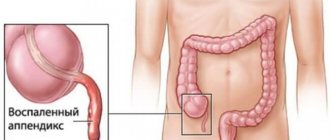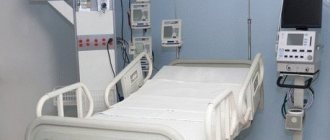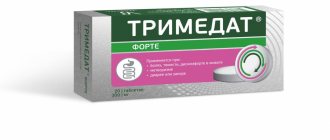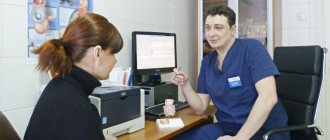Among rectal diseases, hemorrhoids are one of the most common. He appears unexpectedly. First, the patient feels itching in the anal area, then pain, and then notices blood during bowel movements. Is it possible to cure hemorrhoids, how long will it take to be treated? Is it possible to achieve a complete cure or just feel better until the next relapse?
We bring to your attention an informational article on this topic. You should not self-medicate. If you have signs of this disease, make an appointment with a proctologist. With early treatment, it is possible to eliminate painful symptoms using conservative methods, without bringing the condition to surgery.
Methods of surgical treatment
- Desarterization of hemorrhoids - during the procedure, large vessels feeding the venous expansion are ligated. The pathological area, having lost its power source, gradually dies. If required, after disarterization, mucosal lifting and mucopexy are performed - additional suturing of the sagging mucous membrane with a special thread and tightening of the sutured area.
- Laser destruction (vaporization) is a minimally invasive method of removing pathological venous expansion under the influence of a thermal laser beam. The laser acts only on the affected tissue, heats the node, and evaporates the liquid from it. A small scar remains at the site of the removed extension, which prevents relapses. The advantage of the method is that the heat beam seals small blood vessels, this will avoid postoperative bleeding and rough scars on the mucous membrane.
- Thrombectomy from an external hemorrhoid with a laser - removal of a blood clot from the affected area of the vein, sometimes involving the venous wall. The laser machine allows for targeted surgery. The laser beam simultaneously seals the walls of the vein.
Acute hemorrhoids - symptoms and treatment
Currently, there is no uniform treatment strategy for exacerbation of hemorrhoids. Some doctors almost immediately resort to surgical interventions, others only to conservative therapy, and consider surgery appropriate only after the acute process has subsided.
The optimal treatment for acute thrombosis of external hemorrhoids consists of both dynamic observation with complex conservative therapy and surgical correction. Surgical treatment is necessary if acute thrombosis of the hemorrhoid appeared 48-72 hours ago. During the operation, thrombotic masses are either removed from the hemorrhoidal node, or the thrombosed hemorrhoidal node itself is excised. Performing any of these methods within 48 to 72 hours of the onset of acute hemorrhoids will reduce recovery time. If the disease lasts more than 72 hours, then it is necessary to use conservative therapy to relieve pain and inflammation, followed by planned surgical treatment.[1][2][5]
Diet
If you have hemorrhoids, you should eat smaller meals and consume more foods rich in fiber: vegetables, fruits and bran. It is worth refraining from fatty, fried, canned, spicy foods, and also reduce the amount and strength of coffee and tea. It is important to drink enough liquid. This prevents the stool from hardening and promotes the free movement of feces through the intestines.
Drug treatment
Pain is usually relieved with the help of systemic analgesics (analgin, baralgin, ketonal) and local painkillers in various forms (suppositories, creams: anestezol, emla, relief-advance, relief-PRO).
For thrombosis of hemorrhoids, local anticoagulants are used, such as heparin ointment, hepatrombin-g. The use of phlebotonics that help restore the tone of the venous wall (detralex, phlebodia) is also justified. For thrombosis accompanied by inflammation, combination drugs containing an anesthetic and anti-inflammatory components (aurobine, proctoglivenol, drugs from the “relief” line) are indicated.
For bleeding, as a rule, local hemostatic drugs are used in the form of suppositories or ointments (for example, relief, natalsid), it is possible to use hemostatic drugs (tachocomb, hemostatic sponge). In some cases, they resort to prescribing systemic hemostatic agents (dicinone, sodium etamsylate, aminocaproic acid).
Operative therapy
If conservative therapy is ineffective or symptoms progress, traditional surgical treatment is resorted to. The use of minimally invasive techniques for acute hemorrhoids is very controversial, but most experts prefer traditional surgical methods.
The effectiveness of surgical treatment of hemorrhoids
All types of hemorrhoidectomy are the most effective methods of treating OH. The most commonly used are open and closed hemorrhoidectomy, which are performed using a surgical scalpel, diathermocoagulation, laser or ultrasonic scissors.
Closed hemorrhoidectomy (with restoration of the mucous membrane of the anal canal)
This technique is used if there are no clear boundaries between the external and internal hemorrhoids. A clamp is applied to the base of the internal hemorrhoid (above the dentate line). After that, the node is cut off to the vascular pedicle, which is then sutured and bandaged. When suturing the wound, the edges and bottom are captured with an absorbable thread. The external hemorrhoidal node can be excised either together with the internal node or separately.
Complications of this surgical intervention include bleeding in the postoperative period, anal incontinence (incontinence), stricture (narrowing) of the anal canal and constipation.[1][2][7][8]
Open hemorrhoidectomy
This method should be used when OH is combined with an anal fissure or rectal fistula. Excision of the internal hemorrhoid occurs in the same way as with closed hemorrhoidectomy. Thorough hemostasis (stopping bleeding) is achieved. It differs from the closed type of operation in the way the intervention is completed: the wound is not sutured.
The most common complications of this operation are anal incontinence, acute urinary retention and bleeding in the early postoperative period.[3][5][7][9][10]
Submucosal hemorrhoidectomy
The main advantage of this method is the complete restoration of the mucous membrane of the anal canal and rectum with a submucosal location of the stump of the node without deformation or tension. Before the operation, 2-3 ml of a 0.25% novocaine solution is injected into the submucosal layer near the internal node to create a hydraulic cushion. Then the mucous membrane above the node is dissected with two arcuate incisions - this helps to isolate this node from the surrounding tissues down to the vascular pedicle. After which the leg is stitched and the knot is cut off. The mucous membrane of the anal canal is sutured, while immersing the stump of the hemorrhoid into the submucosal layer.
Complications of the operation include reflex retention of urination and bleeding from wounds of the anal canal in the early postoperative period.[1][2][4][6]
Treatment during pregnancy and after childbirth
Hemorrhoids during pregnancy and during breastfeeding are treated with caution. Some drugs are contraindicated in certain trimesters and during lactation. The main method is local treatment - suppositories and ointments prescribed by a proctologist.
Folk remedies
Treatment of hemorrhoids with traditional methods does not have scientifically proven evidence. Without timely and adequate medical care, dangerous complications can develop, such as thrombosis, necrosis and gangrene. Therefore, if you experience pain, bleeding or prolapse of hemorrhoids, you should consult a proctologist.
First aid
When the first symptoms of acute hemorrhoids occur (in particular, pain), it is necessary, if possible, to immediately seek professional help, since there are no reliably effective methods of first aid that can relieve the acute period. In case of exacerbation, you should stop using toilet paper and avoid heavy physical activity. It is possible to use local anticoagulants (heparin ointment, hepatrombin-g), but they should be used with caution, since if the integrity of the node wall is damaged due to necrosis, intense bleeding may begin. The use of painkillers also has a number of certain difficulties: despite the elimination of pain, the progression of the disease will continue, and against the background of a subsided pain syndrome, the patient may postpone a visit to the doctor, thereby aggravating the course of hemorrhoids.
When the symptoms of OH subside, it is necessary to prevent the development of exacerbation in the future. For this purpose, it is necessary to treat chronic hemorrhoids. Today, there are many minimally invasive methods for treating this disease, which involve the use of modern laser, ultrasound, sclerosing techniques, as well as stapler and suture methods. The use of these treatment options makes it possible to minimize, and in some cases completely eliminate, pain and reduce the length of hospital stay to 1 day.
How long does it take for hemorrhoids to heal after surgery?
Modern operations take place with minimal stress on the body. Laser surgery allows targeted action on the affected tissues and does not affect healthy areas of the mucosa. After laser exposure, there is no need to apply stitches, treat the wound, or apply dressings. The entire procedure takes 20–40 minutes, depending on the complexity of the case and the number of nodes. After the node is removed, the patient can return home. The proctologist will give recommendations on what painkillers to take and how to treat the anus in the postoperative period.
Hemorrhoids after laser surgery heal completely within one to two weeks. After just four to five days, you can increase your activity and return to your usual activities. If your job is sedentary, it will be important to take frequent breaks and stretches.
During the recovery period, it is necessary to eat properly so that the stool is moderately soft and regular. The basis of postoperative nutrition is oatmeal, buckwheat, barley, millet porridge with water, lean meat, fermented milk, thermally processed vegetables. It is advisable to eat 4-5 times a day in small portions. It is important to maintain an active drinking regime.
Causes of hemorrhoids
- Increased intra-abdominal pressure due to heavy lifting and excessive physical activity.
- Constipation, in which a person strains excessively during bowel movements. This leads to blood flow, filling and prolapse of hemorrhoids.
- A sedentary lifestyle with blood stagnation in the pelvic area and rectum.
- Pregnancy and the resulting increase in intra-abdominal pressure.
- Alcohol, when abused, causes blood vessels, including those in the anus, to dilate.
How to prevent relapse
Laser surgery reduces the risk of recurrence of hemorrhoids to a minimum. But for a complete recovery you will have to change your lifestyle. It is important to establish regular bowel movements. A diet rich in dietary fiber and movement will help with this. Physical exercise will also help strengthen the venous walls.
Avoid heavy lifting if possible. If you have to sit a lot at work, take breaks every half hour: walk, do simple exercises. Another important aspect is personal hygiene. Choose soft, preferably damp toilet paper; if possible, wash with cool water. Switch to loose underwear made from natural fabrics.
The Clinic of Dr. Grishin employs professional proctologist surgeons. Our patients have access to all types of modern hemorrhoid removal. The clinic is equipped with a laser machine. The operation will take no more than half an hour, and you will go home. The postoperative period will pass quickly, with a minimum of inconvenience, and you will not fall out of your usual rhythm of life.
Symptoms
At first, the patient feels tingling, burning, itching in the rectal area. Painful external or internal lumps form. Discomfort occurs periodically, but quickly passes.
As the disease progresses, blood flow in the veins of the rectum is disrupted. Blood accumulates, hemorrhoids form and become inflamed. When defecating, itching and pain are felt, and bleeding may occur after it.
Gradually, the nodes begin to fall out of the anus. For example, when coughing, when a person is straining or doing heavy physical work. At first he can adjust them on his own. Then the disease enters a stage when only a doctor who knows how to correct hemorrhoids and alleviate the suffering of the patient can help.
Treatment methods
Patients ask what to do if hemorrhoids come out? Modern medicine offers different correction methods. Minimally invasive involves ligating the hemorrhoid with a rubber ring, as a result of which its blood supply is stopped. The procedure takes up to two minutes. Treatment is carried out on an outpatient basis, without hospitalization in a hospital, while maintaining a normal lifestyle. Within 10-14 days, the node dries out and falls off.
Hemorrhoids can be reduced by sclerotherapy. As a result of exposure to thermal energy from the HF device, blood flow to the veins supplying the node is minimized. As a result, it stops filling, becoming inflamed and returns to its normal state. Treatment of external and internal hemorrhoids is carried out with laser, radiosurgical methods, as well as using the TGD procedure, in which the branches of the superior rectal artery are ligated.
The duration of treatment depends on the stage of the disease. When the first symptoms appear, do not delay visiting a specialist. Make an appointment as soon as possible. The doctor will do everything possible to cure the patient without surgery.
Treatment methods for acute hemorrhoids
This disease requires complex therapy, which includes medications, physical therapy and surgery. When the first signs of an exacerbation of the disease appear, you should immediately consult a doctor, where you will be provided with qualified assistance. In most cases, doctors limit themselves to conservative methods of therapy. They are less traumatic and, with the right approach, can quickly and effectively relieve painful symptoms.
Surgical removal of acute hemorrhoids is prescribed in the early stages of thrombosis, when 2-3 days have not passed since the onset of thrombosis of the node. At a later date, drug therapy is first administered to relieve inflammation and surgery is prescribed. To date, the disease has been successfully treated, so the clinical prognosis is favorable.











